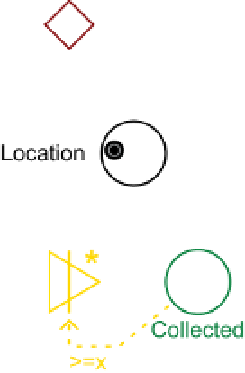Game Development Reference
In-Depth Information
Collectibles also offer a player a strategic option. For example, if the player must risk
lives to collect coins and must collect coins to gain lives, the balance between the
effort and risk the player takes and the number of coins to be collected is crucial. In
this case, if a player has collected nearly enough coins to gain an extra life, taking
more risk becomes a viable strategy.
Figure 6.36
represents this mechanism. Note
that it forms a feedback loop. In this case, the feedback is positive, but the player's
skill determines whether the return on the investment is enough to balance the risk
she takes.
FIGURe 6.36
Feedback in collect-
ing coins that gain new
lives
Racing Games and Rubber banding
Racing games can be easily framed in economic terms as a game where the player's
objective is to “produce” distance. The first player to collect enough distance wins
the game.
Figure 6.37
illustrates this mechanism. Depending on the implementa-
tion, the production mechanism might be influenced by chance, skill, strategy, the
quality of the player's vehicle, or any combination of these factors. The
Game of
Goose
is an example of a racing game in which chance exclusively determines the
outcome of the game. Most arcade racing video games rely heavily on skill to deter-
mine a winner. More representative racing games that include vehicle tuning will
probably involve some long-term strategy as well.
FIGURe 6.37
racing mechanism
A simple racing mechanism as represented in Figure 6.37 has a huge disadvantage. If
skill or strategy is the decisive factor, the outcome of the game will nearly always be
the same. Consider the mechanisms in
Figure 6.38
. It shows two players racing, and
their skill is represented by different chances to produce distance. The chart displays











